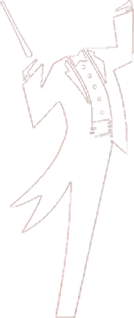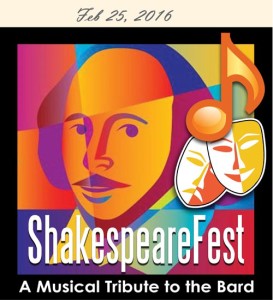[su_row]
[su_column size=”1/2″]
Concert February 25, 2016 at 7:30 PM
Wine & Cheese Reception 6:30 pm
Cailloux Theater – Kerrville, Texas
[/su_column]
[su_column size=”1/2″]
Evening’s Performances
A Midsummer Night’s Dream Felix Mendelssohn
Fantasia on a Theme of Thomas Tallis Vaughn Williams
Morceau de Concert Charles-Camille Saint-Saens
Romeo and Juliet Sergei Prokofiev
Selections from Kiss Me, Kate Cole Porter
[su_row]
To learn more about this concert, see the Conductor Letter and Program Notes below.
[/su_column]
[/su_row]
Conductor Letter
[su_row]
[su_column size=”1/2″]
Dear Symphony of the Hills Community,
William Shakespeare has dominated the literary scene of western civilization for the four hundred years following his death in 1616. His works exhibit the highest levels of accomplishment in both their creative structure and their influence on generations of artists including orchestra composers. Some of our greatest orchestral works were written due to inspiration from the Bard of Avon.
Felix Mendelssohn wrote one of his most celebrated orchestral works to go along with Midsummer Night’s Dream. You can actually picture and feel Shakespeare’s characters and scenery in this piece, especially in the quiet and evocative Nocturne. Audience members will enjoy Saint-Saens Morceau de Concert featuring Symphony of the Hills principal hornist John Raschuber. Sergei Prokofiev wrote his music to Romeo and Juliet to accompany a ballet setting of this tragedy. Cole Porter’s Kiss Me Kate will round out the program with a jazzy setting inspired by the Shakespearean comedy Taming of the Shrew.
[/su_column]
[su_column size=”1/2″]
If you enjoy this Symphony of the Hills concert, I hope you will join our concert sponsor and others throughout the season whose passionate support keeps symphonic orchestral music vibrant in our community.
Thank you for your attendance and I hope to see you at our season finale concert on April 28, “A Night in Old Mexico–South of the Border Favorites.”
With gratitude for your support,
Gene Dowdy
Conductor & Artistic Director
[/su_column]
[/su_row]
Program Notes[su_row]
[su_column size=”1/2″]
A Midsummer Night’s Dream
Felix Mendelssohn
This tribute to Shakespeare, an Overture in E major, was written by Mendelssohn at age 17. Sir George Grove, Director Of the Royal College of Music, called it “the greatest marvel of early maturity that the world has ever seen in music.” Mendelssohn composed the piece as a concert overture after he had read a German translation of the play in 1826; it was not associated with any performance of the play.
The composition is patently romantic although it incorporates many classical elements, being cast in sonata form and shaped by regular phrasings and harmonic transitions. We will note its striking instrumental effects, such as the emulation of scampering ‘fairy feet’ at the beginning and the braying of a donkey (effects which were influenced by suggestions of Mendelssohn’s friend Adolf Bernhard Marx).
Following the first theme in the parallel minor (E minor) representing the dancing fairies, a transition leads to a second theme, that of the lovers. A final group of themes, suggesting the craftsmen and hunting calls, closes the composition. The fairies dominate most of the development section and ultimately have the final word, just as in Shakespeare’s play.
Fantasia on a Theme of Thomas Tallis
Vaughn Williams
Also known as the Tallis Fantasia, this work for string orchestra was composed by the British composer Ralph Vaughan Williams in 1910 and performed for the first time in September of that year. Vaughan Williams himself conducted, and the composition proved to be a major success.
The composition takes its name from the original composer of the melody, Thomas Tallis (c.1505–1585). As was the case with many of Williams’ works, this piece was inspired by the music of the English Renaissance and is scored for an expanded string orchestra divided into three parts: a full-sized string orchestra; a single desk from each section (ideally placed apart); and a string quartet. Williams developed this configuration to resemble the sound of an organ, with the spacing emphasizing the way that the second orchestra several times echoes the first.
In structure this piece resembles the Elizabethan-age “fantasy.” The theme is heard in its entirety three times during the course of the work, but the music grows from the theme’s constituent motives or fragments, with variations upon them. A secondary melody, based on the original, is first heard on the solo viola about a third of the way into the Fantasia, and this theme forms the climax of the work about five minutes before the end.
Morceau de Concert
Charles-Camille Saint-Saens
Charles-Camille Saint-Saëns was a French composer, organist, conductor and pianist of the Romantic era. He was a musical prodigy, making his concert debut at the age of ten. After studying at the Paris Conservatoire he followed a conventional career as a church organist as a successful freelance pianist and composer, in demand in France, mainland Europe, Britain, and the Americas.
Morceau de Concert translates as “concert piece”. It is a solo horn tour de force that Saint-Saens wrote in 1880 as a part of a virtuoso tradition developed in France, upheld mainly by the faculty of the Paris Conservatoire. In the tradition, continued to this day, each study period ends with a competition in which the first prize is awarded to the winner as a symbol of excellence. Saint-Saëns’ composition was dedicated to the horn virtuoso Chaussier, who won the Premier Prix in 1880.
[/su_column]
[su_column size=”1/2″]
Romeo and Juliet
Sergei Prokofiev
Sergei Sergeyevich Prokofiev was a Russian composer, pianist and conductor, regarded as one of the major composers of the 20th century. His works include such widely heard works as Peter and the Wolf, performed by the Symphony of the Hills a couple of years ago. Of the established forms and genres in which he worked, he created seven completed operas, seven symphonies, eight ballets, five piano concertos, two violin concertos, a cello concerto, and nine completed piano sonatas.
Based on a synopsis created by Adrian Piotrovsky and Sergey Radlov, Prokofiev composed the Romeo and Juliet ballet in September 1935. The ballet’s original happy ending (contrary to Shakespeare) provoked controversy among Soviet cultural officials. About this time, two notorious Pravda editorials criticized “degenerate modernists” including Piotrovsky. The fear and caution caused by this publication within the Soviet Russian musical and theatrical community delayed production of the ballet until 1940. The conductor Yuri Fayer met with Prokofiev frequently during the writing of the music, and he strongly urged the composer to revert to the traditional ending. Fayer went on to conduct the first performance of the ballet at the Bolshoi Theatre.
Suites of the ballet music were heard in Moscow and the United States, but the full ballet premiered in the Mahen Theatre, Brno (now in the Czech Republic), on 30 December 1938. It is better known today from the significantly revised version that was first presented at the Kirov Theatre in Leningrad on 11 January 1940, with Konstantin Sergeyev and Galina Ulanova in the lead roles.
Selections from Kiss Me, Kate
Cole Porter
Loosely based on William Shakespeare’s play The Taming of the Shrew, this extremely popular 1948 Broadway musical revolved around the conflict on and off-stage between Fred Graham, the show’s director, producer, and star, and his leading lady, his ex-wife Lilli Vanessi. A secondary romance concerns Lois Lane, the actress playing Bianca, and her gambler boyfriend, Bill, who runs afoul of some gangsters. The original production starred Alfred Drake, Patricia Morison, Lisa Kirk and Harold Lang and won a Tony Award.
Concert Notes by Jim Adams
[/su_column]
[/su_row]



